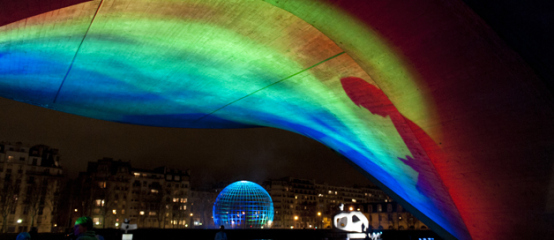19 January 2015 — Tonight, an Aurora Borealis graced UNESCO’s Globe in Paris. The Northern Lights, a natural phenomenon only seen in much higher latitudes, were reproduced by artist Kari Kola on the UNESCO Headquarters in celebration of the International Year of Light 2015, which opened with a special event on 19 and 20 January.
“I have been fascinated by light for as long as I can remember”, said Finnish artist Kari Kola. “In Finland, autumns and winters are long and dark. I wanted to teach myself to use light to make most of the darkness that surrounded me during those times of year. When it’s dark 20 hours a day, you can really make a difference with light.”
He chose to represent the Aurora Borealis in a stylistically abstract form through his installation “Light is Here”, bathing the buildings in blues and greens, in contrast with the warmer colors of dawn.
“I was 1 year old when I first saw the Northern Lights, and I’ve seen them every year since. But I have learned most of what I know about light by watching the sunrise.”
The main objective of the International Year of Light and Light-based Technologies (IYL2015), which is led by UNESCO, is to raise global awareness of how light-based technologies can provide solutions to the global challenges of sustainable development.
Light-based technologies have many applications in fields as diverse as medicine, communications or energy. They offer the possibility of a transition towards more sustainable lifestyles, and can contribute to alleviate poverty, especially for 1.3 billion people living off the grid, with no access to electricity.
The 2-day event gathered over 1,000 participants, including decision makers, industry representatives and leading scientists.
Nobel Prize Laureates
Five Nobel Prize laureates are giving lectures: Ahmed Zewail (“Light and Life”); Steven Chu (“Energy and Climate Change: Challenges and Opportunities”); William Phillips (“Einstein, Time and Light”); Serge Haroche (“Light and the Quantum”) and Zhores Alferov (“Efficient Light Conversion and Generation”).
The launch of the international Year of Light is also punctuated by thematic sessions on various topics, such as the role of optical technologies in development, the future of light-based technologies and the practical solutions they can provide.
The event was a tribute to the scientific and cultural aspects of light.
These were illustrated through exhibits and performances, notably a recital by American violinist Joshua Bell and a performance of the Maori founding myth Te Ao Mārama – From Darkness to the World of Light. Another highlight is the inauguration of the “1001 Inventions and the World of Ibn Al-Haytham” campaign, launched by UNESCO in partnership with the science and cultural heritage organization 1001 Inventions. Ibn Al-Haytham, a 10th century scholar from Basra (Iraq), is considered to be the father of modern optics and of the present-day scientific experimental method.
The Year coincides with the 1,000th anniversary of his seminal work, Kitab al-Manazir (Book of Optics).
Light is Here, created by Kari Kola and installed by Valoparta Ltd., will illuminate UNESCO for one last night, tomorrow 20 January 2015. (*Source: UNESCO).













